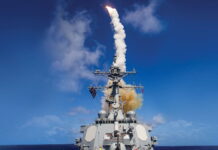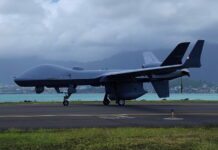As aerial threats continue to evolve, air defence likewise evolves to keep pace. This article explores how changing battlefield dynamics have driven the US military to continuously reimagine its air defence systems, from legacy systems to the latest programmes aimed at defending the skies of tomorrow.
The US Army has rarely fought under unfriendly skies, and has nearly always been able to rely on US air superiority. Given this background, it is perhaps not unsurprising that for many decades tactical surface-to-air (SAM) systems able to protect front-line forces were never given a high priority. But by the late 1950s, the US Department of Defence (DoD) saw the need for short-range SAM systems mounted on vehicles, able to redeploy quickly in order to defend mobile assets.
In 1960, development began on the General Dynamics MIM-46 Mauler, a system that would mount search and target illumination radars, plus a launcher armed with nine launch containers mounted onto a turret fitted on an M113 armoured vehicle. The project was unsuccessful, so a lower-technology solution was fielded by the US in the form of the Ford Aerospace MIM-72 Chaparral. This mounted a four-round launcher for adapted AIM-9 Sidewinder missiles onto a tracked chassis. Chaparral remained in US service until the 1990s, and is still operational with Egypt, Morocco, Taiwan and Tunisia. Egyptian systems are reported to have been upgraded under a programme launched in 2000. Chile, Ecuador, Israel, and Portugal also procured Chaparral, but have now retired the system.
A late-1970s plan to create a US-built version of the Euromissile Roland mobile SAM system did not proceed smoothly, and only 27 fire units and 600 missiles were built, and briefly served with the US Army National Guard.
Stinger: The lightweight SAM
More recent US vehicle-mounted systems have all been based on the Raytheon FIM-92 Stinger family of missiles. Originally developed as a shoulder-launched man-portable air defence system (MANPADS) able to replace the earlier General Dynamics FIM-43 Redeye, Stinger is perhaps unique in terms of US missile designations in that it tends to be referred by series name rather than by its traditional number/letter designations.
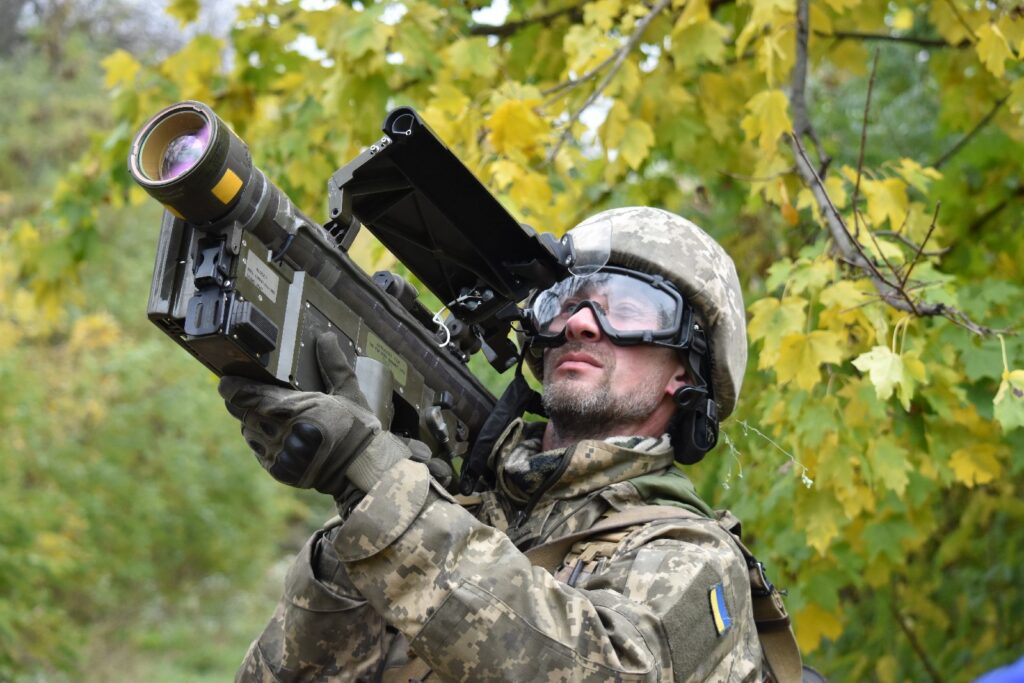
The designation Stinger-RMP Block I has been applied to several versions. An upgraded sensor and the software intended to improving the missile’s performance against low-signature targets resulted in the FIM-92E delivered from 1995 onwards, while a further software upgrade introduced in 2001 created the FIM-92F. A service life extension is expected to keep the Block I in service until 2030.
Stinger-RMP Block II (FIM-92I) entered development in 1996 with the goal of using a new focal- plane-array sensor to improve the missile’s effectiveness in high clutter environments, and giving increased target-detection distance. It should have entered production in 2004 but fell victim to budget cuts.
Stinger models -92A to -92I were fitted with a contact fuze which responds to a direct impact with the target. While this was an effective solution for larger threats such as aircraft and cruise missiles, it was less suitable for smaller and more elusive targets such as smaller drones. Tests of rounds fitted with proximity fuzes, known as Stinger PROX, were completed in the summer of 2017, and included firings against an MQM-170C Outlaw and an unidentified smaller target. Stinger PROX exists in two variants. FIM-92J is an upgrade of the Block I missile which replaces ageing components in order to extend the missile’s service life a further 10 years. It adds a proximity fuze intended to improve lethality against UAVs, and replaces ageing subsystems such as the flight motor and gas generator. FIM-92K is similar, but reported to also include a datalink for vehicle-mounted targeting applications.
The Stinger production line closed in December 2020, but in 2022 the US Government signed a USD 687 million contract for 1,468 Stinger rounds intended to replenish US stocks following the supply of missiles to Ukraine. It was understood that these are being delivered through refurbishment of older missiles rather than new-build production. However, since some of the components needed are no longer commercially available, the electronics in the seeker head will have to be redesigned once current component stocks are exhausted.
In 2021, Raytheon successfully demonstrated that a Stinger missile could be fired from a Javelin Lightweight Command Launch Unit (LWCLU); the missile engaged a UAV. If adopted for operational use, this capability would allow personnel to engage air and ground targets while carrying only a single type of launch system. In July 2024, the NATO Support and Procurement Agency (NSPA) signed a multi-year contract worth USD 780 million for the procurement of 940 FIM-92K Stinger Block I to be delivered to Germany, Italy, and The Netherlands.
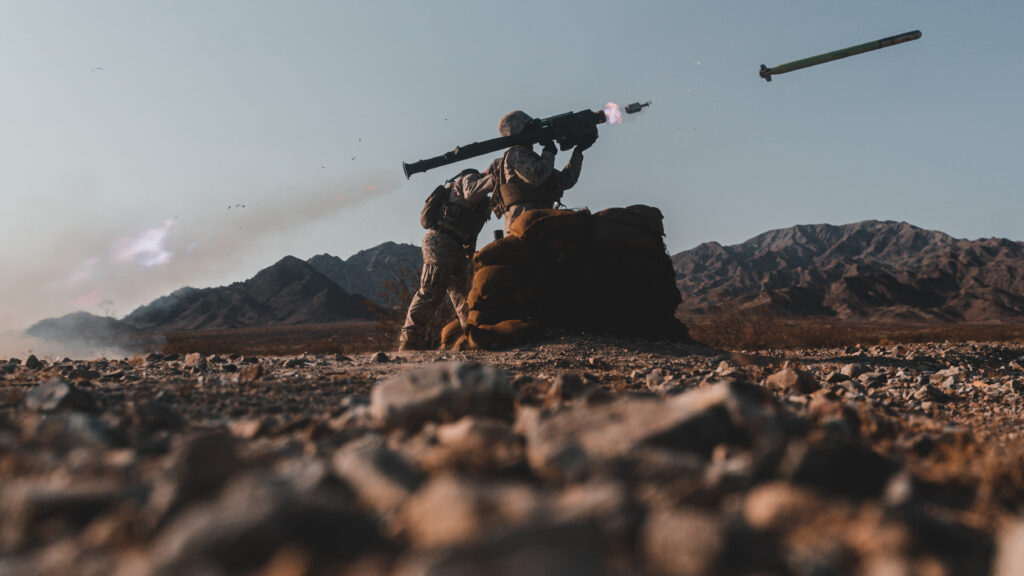
Alongside its infantry-portable variant, Stinger has been fielded on self-propelled anti-aircraft vehicles. For several decades, this role was in US service was filled by the Boeing AN/TWQ-1 Avenger. This vehicle consists AM General 4×4 high-mobility multipurpose wheeled vehicle (HMMWV), with a gyro-stabilised one-person turret on the rear, armed with two pods of four ready-to-launch Stinger missiles. Developed in the early 1980s, it was selected by the US Army in 1987 after a competitive evaluation of rival designs, and ordered into production. Deliveries started in 1988 with Taiwan placing an order for 74 fire units – delivered in 1999. Known export users of the Avenger are: Bahrain, Chile, Egypt, the Kurdistan region, Iraq, Lithuania, Taiwan, and Ukraine. At least 20 Avenger systems are known to have been supplied to Ukraine since 2022. More recently, Stinger has also served as the effector of choice for the newer Maneuver-Short Range Air Defense (M-SHORAD) Increment 1 system.
The US Army ups its VSHORAD game
With much of its recent combat experience having been in the Middle East, the US Army had neglected its very short-range air defence (VSHORAD) capabilities. Realising this capability gap, and the future threat posed by UAVs, it launched the M-SHORAD programme to develop and field a Stinger-armed version of the Stryker eight-wheeled armoured fighting vehicle.
In 2018, Leonardo DRS was selected to supply the mission equipment package and to work with Moog to integrate the reconfigurable integrated-weapons platform (RIwP) onto the vehicle. The reconfigurable turret is armed with an M230LF 30 mm chain gun, coaxial M240 7.62 mm machine gun, a pod of four Stinger missiles, and two launch rails for AGM-114L Longbow Hellfire missiles. For target detection, it is equipped with four fixed-face DRS RADA RPS-42 multi-mission hemispheric radar (MHR) antennas. By late 2022, the 5th Battalion, 4th Air Defense Artillery Regiment had become the first fully-equipped unit to operate what has become known as M-SHORAD Increment 1, which has now been allocated the name ‘Sgt Stout’. US Army representatives previously confirmed to ESD that there are plans to fit a second pod of Stinger missiles in place the of the Hellfire launcher, so that each vehicle will have eight ready-to-fire Stinger rounds. These efforts appear to have started in 2024.
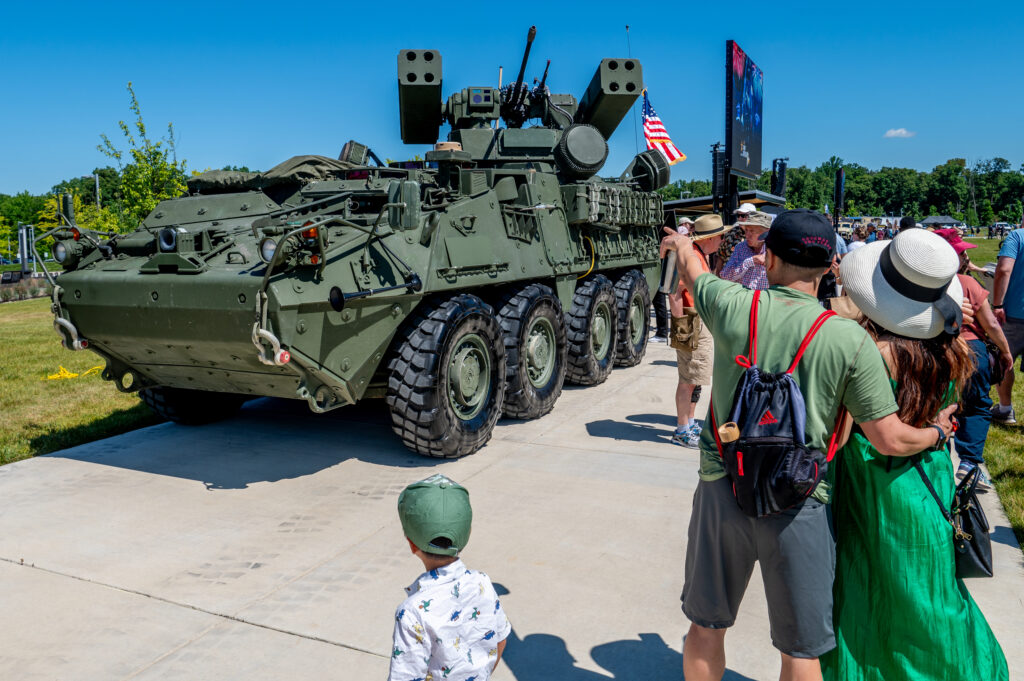
On 8 May 2024, the Army issued a request for information (RFI) for a planned M-SHORAD Increment 4. The proposed system is to be capable of integration onto ground platforms such as the Joint Light Tactical Vehicle (JLTV) and/or a robotic vehicle, and the intention is to make the system transportable on a C-130 aircraft, air-droppable, and suitable for delivery as a sling load. The Army envisages a series of solutions that would meet near-term (FY2027 to FY2028), mid-term (FY2030 to FY2032), and long-term (beyond FY2035) requirements.
To meet its own air-defence needs, the US Marine Corps plans to arm its Low Altitude Air Defense Battalions with the Marine Air Defense Integrated System (MADIS). The system uses two JLTVs, one armed with turret-mounted Stinger missiles, while the other has a 360° surveillance radar and a command and control suite. Both vehicles have a direct-fire weapon on a remote weapons station, an optoelectronic infrared sight, and an electronic warfare system. In December 2023, a low-rate initial production model successfully engaged several drone targets during live-fire testing at the Yuma Proving Ground in Arizona. Some were engaged by Stinger missiles, others by 30 mm cannon fire. The USMC’s 3rd Littoral Anti-Air Battalion was scheduled to be the first unit to receive the MADIS.
Plugging the C-RAM gap
Intended to protect high-value military sites against enemy cruise missile, UAVs, rocket, artillery, and mortar (RANI) attacks, the US Army’s indirect fire protection capability (IFPC) system is expected to consist of a launcher and interceptors able to bridge the gap between existing VSHORAD systems and PATRIOT.
The initial solution adopted by the US Army had been Rafael’s Iron Dome, but its service with the Army was to prove short-lived. On 12 October 2023, less than a week after the Hamas attack against Israeli communities living close to Gaza, and the start of a major rocket bombardment of Israel by Hamas, Washington allowed US-owned Tamir missiles that were still in Israel to be transferred to Israeli ownership for potential use by the country’s Iron Dome batteries. A week later it announced that the hardware of both of the US batteries would be returned to Israel.
When Iron Dome proved unsatisfactory, the Army launched the IFPC Increment 2 programme, and in September 2021 awarded a three-year prototype Other Transaction Authority Agreement (OTA) to Dynetics (a subsidiary of Leidos) for the development and delivery of 16 launcher prototypes, 60 interceptors, and associated all-up-round magazines.
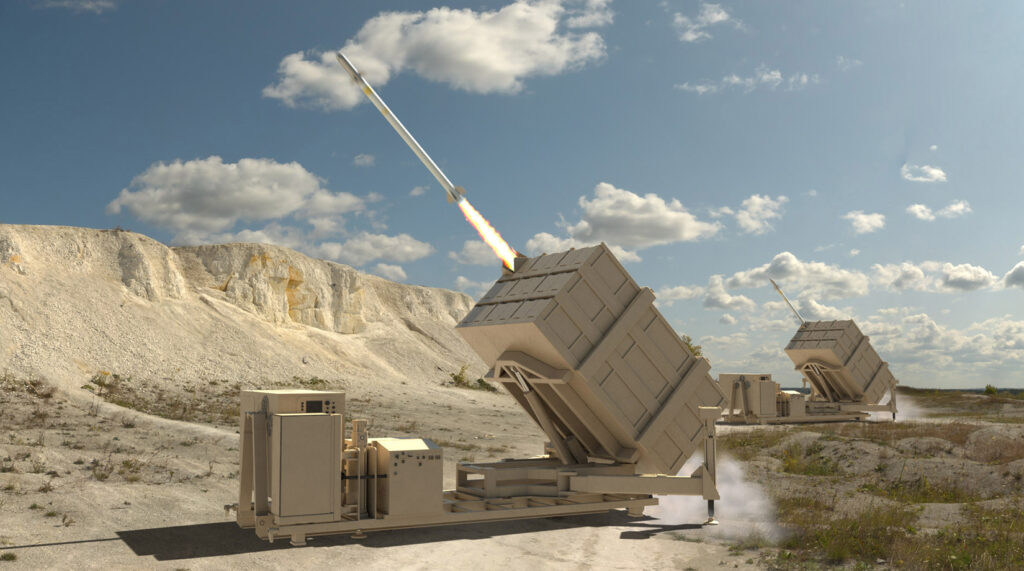
A June 2024 report by the US Congressional Research Service (CRS) cited one unidentified official as saying: “It is now clearer that the service needs a second interceptor that is more capable against lower flying, supersonic cruise missiles.” The National Advanced Surface to Air Missile System (NASAMS) had been mentioned as a potential candidate, but the US Army is reported to want a missile that would offer a capability similar to that of the AIM- 120D, while being small enough to allow 18 rounds to be carried in the IFPC Increment 2 launcher. Development of such a missile would probably take the rest of the current decade, with low-rate initial production starting sometime after 2030, the CRS predicts.
The US Marine Corps (USMC) on the other hand had a more positive experience with Iron Dome, and adopted some of its components while also seeking to make the overall system more mobile. The resulting medium-range intercept capability (MRIC) can be thought of as a towed variant of Iron Dome with mostly US components. MRIC integrates several existing systems: the AN/TPS-80 Ground/Air Task-Oriented Radar (G/ATOR); the Skyhunter (the US domestic variant of the Tamir) missile and the Common Aviation Command and Control System (CAC2S) as the command post. Early live-fire tests conducted by personnel from the equipment manufacturers and from the programme office have gone well, and will lead to the training of a USMC air-defence battalion. Following a reportedly successful quick reaction assessment (QRA) in late 2024, the system is expected to move into production in 2025.
SAMs able to provide top cover
From 1958 onwards, the Western Electric (later Douglas) MIM-14 Nike Hercules was widely deployed by the US and its allies. Known export users were Belgium, Denmark, West Germany, Greece, Italy, Japan, The Netherlands, Norway, South Korea, Taiwan, and Türkiye.
In 1983, the US began to field the Raytheon PATRIOT as a Nike-Hercules replacement, but other NATO nations kept the older system operational until the late 1980s. Known export customers for PATRIOT are Bahrain, Germany, Greece, Israel, Japan, Kuwait, The Netherlands, Poland, Qatar, Romania, Saudi Arabia, Spain, Sweden, Switzerland, South Korea, Taiwan, Ukraine, and the United Arab Emirates.
Israel seems to have been the first user to retire the system. By early 2024, that country was reported to have begun phasing out some PATRIOT batteries, and all were expected to be withdrawn from service by mid-2024. Israel will now rely on its Iron Dome and David’s Sling systems, which were designed specifically to counter rockets and missiles, which are in practice the prime threats the country faces.

The original AN/MPQ-53 radar of the PATRIOT system used a passively-scanned phased array antenna, but in 2014 Raytheon demonstrated an active electronically-scanned (AESA) antenna based on Gallium nitride (GaN) technology, which would become known as the Lower Tier Air and Missile Defense Sensor (LTAMDS). This demonstrated roughly twice the range, an increase in azimuth coverage, and improved reliability. While the main GaN-based AESA array is oriented toward the primary threat, two new rear panel arrays, each about quarter the size of the main array, serve to provide all-round coverage, a first for PATRIOT.
The company identified a number of design changes for PATRIOT that would allow the system to work with LTAMDS, and following a contract award in 2019, it built six LTAMDS radars. To accelerate the programme, all six were rotated through simultaneous integration and testing at company and US government sites. During contractor verification tests, the complexity of the simulated threats was increased incrementally. In a trial conducted in November 2023 at the White Sands Missile Range, New Mexico, a PATRIOT PAC-3 system integrated with the LTAMDS radar engaged an air-breathing target. In March 2024, military leaders from seven countries were at White Sands to witness the latest in a series of successful live-fire events involving the LTAMDS radar, which acquired and tracked a cruise missile surrogate flying at high altitude, high speed and at a long range in a potential operational environment. Milestone C, the transition from development to production, is expected in the second quarter of 2025.
In 2023, the Polish Minister of Defence approved a Letter of Acceptance with the US Army for a scheme to enhance its existing PATRIOT systems with 12 LTAMDS radars. The resulting low-rate initial production batch of radars is due to be completed by November 2028.
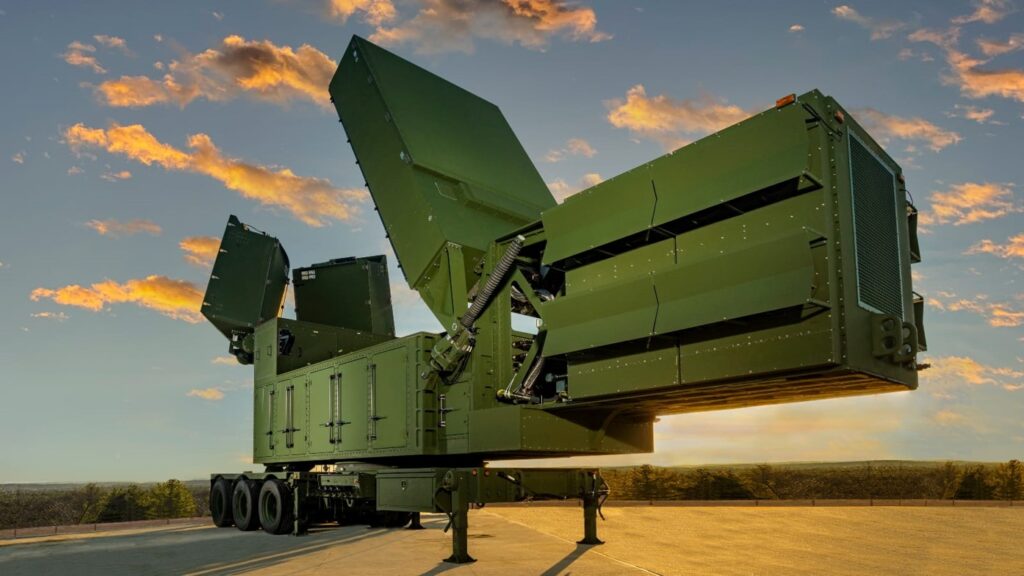
In order to deal with emerging air and missile threats, including targets flying at hypersonic speed, the US Army had planned to develop a Lower-Tier Future Interceptor (LTFI) that could eventually replace PATRIOT. However, the likely cost of this proposed missile doomed the programme, and its cancellation was announced in October 2024. The Army now plans to develop an upgraded version of the current production PAC-3 Missile Segment Enhanced (MSE) interceptor.
Standard becomes the USN solution
The US Navy (USN) has memories of surface ships having to defend themselves (sometimes unsuccessfully) against air attack. It is perhaps not unsurprising that naval SAM systems have always enjoyed a high priority.
By the early 1970s, the USN was conducting regular combat operations in waters close to the coast of North Vietnam, and realised that its ships needed a point-defence system able to counter the threat posed by Russian-supplied P-15 Termit (SSN-2 ‘Styx’) anti-ship missiles. By the summer of 1972, it had deployed a naval version of Chaparral aboard its Gearing (FRAM-1) class destroyers.
These Sea Chaparral systems had only a brief service life, and were removed in the following year. However, in 1974 the system was adopted by Taiwan. The last ships still fitted with the system are Taiwan’s Kang Ding (Lafayette class) frigates, with Sea Chaparral being replaced by the indigenously-developed Hai Chen II missile system.
The current short-range SAM system used by the USN is the Raytheon RIM-116 SeaRAM. This consists of a 21-cell missile launcher linked to other onboard defences such as the radar and optoelectronic system of the Phalanx CIWS Mk-15 Block 1B. The original Block 0 configuration used a passive radio frequency (RF) subsystem for midcourse guidance, then transitioned to infrared passive homing for the terminal phase of flight. Block 1A missiles can fly an autonomous IR-all-the-way attack, so are effective against threats that do not rely on onboard radar seekers. The Block 2 missile has a larger rocket motor, an improved control section fitted with four canard control fins rather than the two used by earlier variants, and an evolved RF receiver. Current export users are Egypt, Germany, Greece, Japan, Mexico, Qatar, Saudi Arabia, South Korea, Türkiye, and the UAE.
The only variant of the original Standard 1 missile is the RIM-66E (SM-1MR Block VI). While no longer in service with the USN, the RIM-66E remains in service with other export users. The RIM-66C/D Standard MR (SM-2MR Block I) was developed in the 1970s as part of the Aegis combat system and New Threat Upgrade (NTU) programme. It uses a combination of inertial and command mid-course guidance, so requires target illumination by shipboard radars for a few seconds in the final stage of flight. This greatly increases the number of targets that can be engaged in quick succession.

On 19 October 2023, three land-attack cruise missiles and eight UAVs launched from Houthi-controlled territory in Yemen were successfully intercepted by SM-2 missiles fired from the Arleigh Burke class destroyer USS Carney. The ship was not under threat, but missiles and UAVs had been flying north towards Israel. Further missile and UAV attacks by Houthi forces were engaged by USN warships between October 2023 and January 2024. Most of these engagements were conducted using SM-2 missiles, whose unit procurement cost was much higher than that of the targets being shot down. During a ‘blue-on-blue’ incident in the Red Sea area in February 2024, the German Sachsen class frigate Hessen launched two SM-2 missiles at a US MQ-9 Reaper drone, although both SM-2s were reported to have crashed into the sea due to an unspecified technical problem.
On 22 December 2024, the USN Ticonderoga class guided-missile cruiser USS Gettysburg, which was engaged in USN operations in the Arabian Gulf, launched a missile against an F/A-18F Super Hornet of Strike Fighter Squadron 11 (VFA-11) from the aircraft carrier USS Harry S. Truman. This resulted in destruction of the aircraft, whose crew survived the incident. The results of the formal inquiry into the incident had not been published by the time this issue of our journal closed for press, but according to a posting on 25 December on X (formerly Twitter) that claimed to be by the pilot of the downed aircraft, the crew had seen the incoming missile, and decided to eject when they realised their aircraft was the target. A second missile launched by the USS Gettysburg was reported to have targeted a second F/A-18F, but the latter aircraft successfully conducted evasive manoeuvres.
The longer-range RIM-156A Standard SM-2ER Block IV incorporates a Mk 72 booster, but is able to be installed in the Mark 41 vertical launching system. The RIM-174 Standard extended range active missile (ERAM) – also known as Standard Missile 6 (SM-6) – was designed for extended-range anti-air warfare (ER-AAW) purposes. It is not intended to replace the SM-2 series, but to act as a longer-range adjunct. Able to engage fixed and rotary-wing aircraft, anti-ship cruise missiles, and UAVs, the RIM-174 can also conduct terminal defence interceptions of ballistic missiles. It combines the airframe of the earlier SM-2ER Block IV (RIM-156A) missile with the active radar seeker of the AIM-120C AMRAAM. The latter feature improves performance against highly agile targets, and allows the missile to engage targets beyond the effective range of the launching vessels’ target illumination radars. The RIM-174 achieved initial operating capability in November 2013.
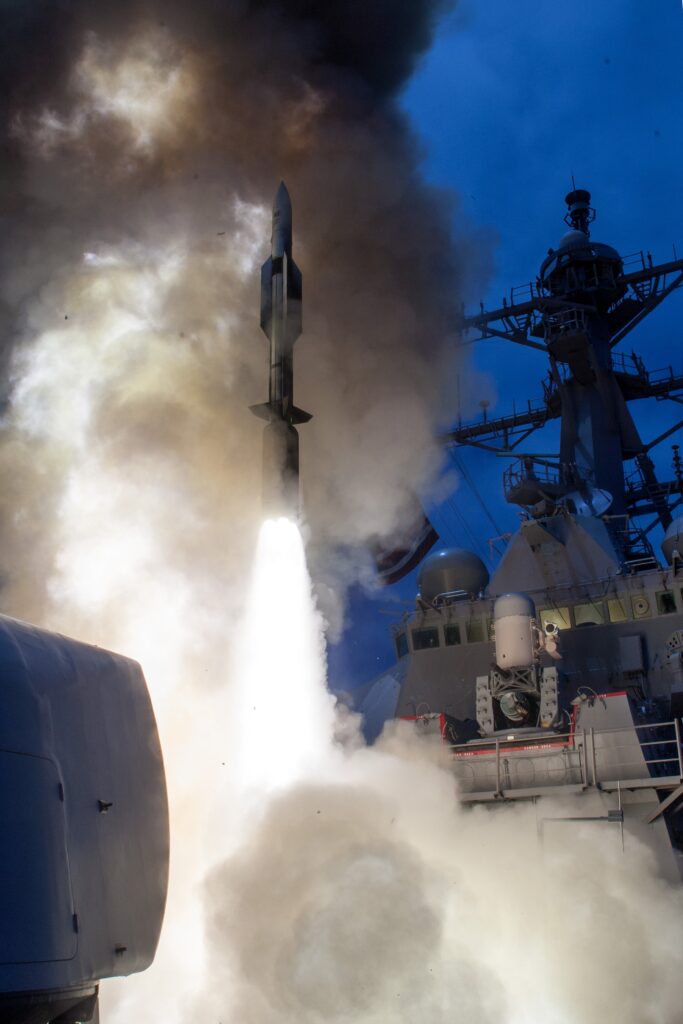
During exercise Valiant Shield 24 in July 2024, Raytheon demonstrated a simulated complex engagement that used track data from Army LTAMDS simulators and its Integrated Air and Missile Defense Battle Command System (IBCS) to link with the Navy’s SM-6 engagement control software.
While the range of targets engageable by the SM-6 includes ballistic missiles, some of the threats currently faced by US warships are of modest performance, so hardly constitute viable targets for the Standard Missile. Once again, Stinger has proved a potential solution. Since 1984, Stinger has been used for point defence by many USN warships, particularly those operating in Middle Eastern waters. The engineers who developed the Stinger in the early 1970s could have had no idea of the flexibility and future roles of the weapon they were creating.
Doug Richardson








